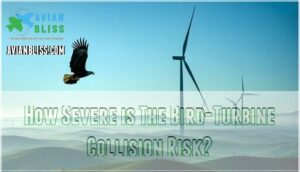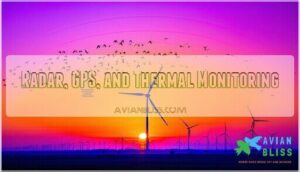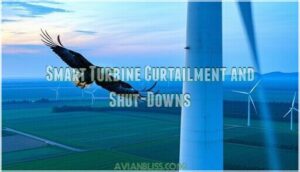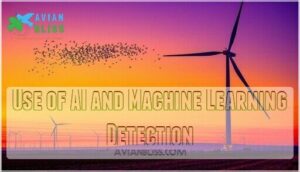This site is supported by our readers. We may earn a commission, at no cost to you, if you purchase through links.

The answer lies in their visual limitations—fast-spinning turbine blades create motion blur that overwhelms bird vision, making the massive structures appear transparent or invisible against the sky.
Birds also lack evolutionary adaptations to recognize these modern threats, since natural selection never prepared them for industrial obstacles spinning at 200+ mph.
Weather disrupts their navigation during migration, while bright warning lights actually attract nocturnal species toward the turbines.
The combination of ancient instincts meeting cutting-edge technology creates unexpected collision patterns that researchers are still unraveling.
Table Of Contents
- Key Takeaways
- Why Do Birds Fly Into Wind Turbines?
- How Severe is The Bird-Turbine Collision Risk?
- What Research Reveals About Bird Collisions
- Effective Strategies to Reduce Bird Collisions
- Balancing Wind Energy and Bird Conservation
- Frequently Asked Questions (FAQs)
- Why do birds die at wind farms?
- Does wind energy affect birds?
- Do wind turbines kill birds?
- Why do birds not see a wind turbine?
- Why are birds attracted to wind turbines?
- How often do birds fly into wind turbines?
- How do you keep birds from hitting wind turbines?
- What are the causes of bird collisions with wind turbines?
- Whats the biggest threat to bird populations?
- Why do birds collide with wind turbines?
- Conclusion
Key Takeaways
- You’ll find that birds can’t see fast-spinning turbine blades clearly due to motion blur – the blades create visual streaks that overwhelm their processing abilities, making massive structures appear transparent against the sky.
- Birds haven’t evolved to recognize wind turbines as threats since these industrial obstacles didn’t exist during millions of years of natural selection, leaving them unprepared for spinning blades that reach 200+ mph.
- Weather disrupts bird navigation during migration while bright warning lights actually attract nocturnal species toward turbines, creating a perfect storm of collision factors.
- You can reduce bird deaths through smart detection systems that automatically shut down turbines when birds approach, strategic wind farm placement away from migration routes, and simple visual modifications like painting one blade black for better visibility.
Why Do Birds Fly Into Wind Turbines?
You’ve probably wondered how birds can miss something as massive as a wind turbine, but the science behind these collisions reveals several fascinating factors at play.
Birds face a perfect storm of visual limitations, evolutionary gaps, and environmental challenges that make wind turbines surprisingly difficult obstacles to avoid, involving visual limitations.
Birds’ Visual Limitations and Motion Smear
Most birds can’t see turbine blades clearly when they’re spinning fast.
Fast-spinning turbine blades create visual blur that birds simply cannot process in time
Your eyes work differently than theirs – birds experience motion blur and visual acuity problems that create deadly optical illusions around rotating turbine blades.
Here’s what affects bird perception near turbines:
- Motion Blur – Fast-moving blades create visual streaks that birds can’t process quickly enough
- Limited Visual Acuity – Birds struggle to detect blade edges against sky backgrounds during flight
- Turbine Visibility Issues – Spinning rotors appear transparent or invisible, masking collision risks
The risk of collision is increased by turbine design flaws.
Lack of Evolutionary Adaptation
You can’t blame birds for not recognizing wind turbines as threats—these structures didn’t exist when bird instincts evolved over millions of years.
This adaptive failure creates evolutionary gaps where bird vision and bird behavior haven’t developed visual cues to detect spinning turbine blades.
Species vulnerability increases because bird collision risks weren’t part of natural selection, leaving modern birds unprepared for bird strikes against these industrial obstacles, which is a result of evolutionary gaps.
Attraction to Turbine Lights and Structures
Wind turbines become bird magnets through their bright warning lights and towering structures.
These visual cues create dangerous bird disorientation, especially for species with strong nocturnal habits.
Aviation lights required for safety ironically attract birds during nighttime flights.
The tall towers themselves serve as perches for raptors, creating hunting grounds that increase bird strikes and wind turbine collision risk, due to the visual cues.
Nocturnal and Migratory Bird Behaviors
During migration seasons, you’ll witness millions of songbirds flying at night when turbines pose maximum collision risks.
These nocturnal travelers rely on sensory perception that evolution hasn’t equipped for modern obstacles.
Migration patterns often intersect turbine flight altitudes of 400-500 feet, creating deadly encounters.
Disoriented birds struggle with nocturnal navigation around spinning blades, leading to increased bird mortality during peak migration periods.
When weather influence disrupts traditional routes, it can lead to increased bird mortality during peak migration periods, making the situation even more critical for the nocturnal travelers.
Weather and Environmental Influences
During storms and high winds, you’ll find birds struggle with sudden Wind patterns that throw off their natural navigation systems.
Seasonal migration routes become treacherous when turbines sit in traditional flyways, creating unexpected Bird Collision Risks.
Air pressure changes from weather fronts disorient migrating flocks, making Wind Energy Impact studies essential for Environmental Impact Assessment and Climate Change Mitigation planning.
How Severe is The Bird-Turbine Collision Risk?
While bird-turbine collisions capture headlines, you might be surprised to learn that wind farms account for just 140,000 to 679,000 bird deaths annually in the United States.
To put this in perspective, that’s substantially fewer than the billions killed by cats, building strikes, or even traditional power lines each year, which highlights the relatively minor impact of wind farms on bird populations compared to other human-related factors, such as traditional power lines.
Collision Rates and Species Most Affected
Annually, wind turbines across America kill between 681,000 and 1.17 million birds, with mortality estimates projected to reach 1.4 million by 2030.
Small songbirds face the highest Species Vulnerability, accounting for 57-60% of bird deaths at wind farms.
Regional Variations in Data Collection reveal raptors like Red-tailed hawks suffer disproportionate Impact Severity despite representing only 7% of fatalities, as their low reproductive rates amplify bird collision risks.
These numbers are substantially lower than deaths caused by other sources, as cats kill many more birds.
Turbine Blade Speed and Height
Turbine blade tip speeds reach up to 180 mph, creating deadly collision trajectories for birds flying at typical rotor height altitudes of 400-500 feet.
The combination of high blade tip speed and strategic rotor height impact explains why wind turbines pose significant collision risks.
Despite bird deaths being relatively low compared to other hazards, the overlap with bird flight paths and altitude effects make wind turbines particularly dangerous.
Comparison With Other Human-Made Hazards
When you consider the bigger picture, wind turbines don’t top the list of bird killers.
Cat predation claims up to 4 billion bird deaths annually, while building collisions kill nearly 1 billion birds yearly.
Power lines cause 12-64 million bird deaths compared to wind turbines’ 140,000-679,000, and fossil fuels actually kill more birds per energy unit produced than wind turbines.
Some studies suggest that painting turbine blades can substantially reduce bird collisions, making wildlife conservation and climate change mitigation complementary goals.
What Research Reveals About Bird Collisions
You’ll discover that scientists use multiple research methods to understand when, where, and why birds collide with wind turbines.
These studies combine field observations, advanced tracking technology, and data analysis to reveal patterns that help reduce future bird deaths, utilizing complete concepts to improve understanding.
Field and Visual Surveys
Scientists observe birds around wind farms through systematic field studies to understand collision patterns.
Survey methodologies track species identification throughout different seasons, revealing which birds face the greatest risks.
Visual surveys document habitat assessment data, showing how various species use wind farm areas for feeding and nesting.
However, survey limitations mean researchers can’t catch every bird death, making data interpretation challenging when calculating actual bird collision rates at wind turbines.
Researchers use bioacoustic monitoring systems to capture bird vocalizations, which helps in understanding the bird population and their behavior around wind farms, ultimately aiding in assessing the wind farm areas.
Radar, GPS, and Thermal Monitoring
Beyond visual surveys, researchers employ advanced technology to track bird movements around wind farms.
Radar systems provide radar accuracy in detecting bird flight patterns, while GPS tracking follows individual migration routes.
However, thermal limitations affect nighttime monitoring capabilities.
Data integration combines these technologies for thorough analysis, enabling predictive modeling to forecast collision risks.
- Radar systems detect birds up to 1,500 meters away from turbines, tracking flight paths in real-time
- GPS collars on tagged birds reveal migration corridors and altitude preferences near wind farms
- Thermal cameras monitor nocturnal bird activity when visual observation isn’t possible
- Integrated monitoring platforms combine radar, GPS, and thermal data for complete coverage
- Machine learning algorithms analyze movement patterns to predict high-risk collision periods
The use of advanced technology and machine learning algorithms allows for a more comprehensive understanding of bird movements and behaviors around wind farms.
This information can be used to develop strategies for reducing the impact of wind farms on bird populations, such as reducing collision risks.
Data Analysis and Collision Pattern Insights
Through careful data analysis, researchers uncover collision hotspots where Bird Deaths concentrate at specific Wind Turbines.
Temporal patterns reveal when Bird Collisions peak during Bird Migration Patterns, helping identify Species vulnerability windows.
This research enables Predictive modeling to forecast risks and measure Mitigation effectiveness, turning raw collision data into actionable insights that protect birds while supporting Wind Farms.
Effective Strategies to Reduce Bird Collisions
You can dramatically reduce bird collisions at wind turbines through proven technological and planning strategies.
These methods range from smart sensors that detect approaching birds to strategic placement of wind farms away from critical migration routes, utilizing proven techniques to minimize harm.
Smart Turbine Curtailment and Shut-Downs
Smart turbine curtailment and shut-downs represent powerful tools for protecting birds at Wind Farms.
AI Bird Detection systems paired with Automated Shutdown Systems can stop turbines within seconds when birds approach.
Real-time Monitoring through radar and cameras enables Predictive Curtailment Models to anticipate dangerous conditions.
While Economic Feasibility remains a concern, these technologies show promising results for Turbine Collision Reduction.
Strategic turbine placement can substantially reduce collision risks.
- Advanced radar systems can detect approaching flocks from miles away, giving turbines time to safely stop
- Smart curtailment during peak migration periods protects thousands of birds without major power losses
- Automated systems work 24/7, never missing the split-second timing needed to prevent Bird Collisions
- Machine learning improves detection accuracy over time, reducing false alarms while keeping birds safer
Blade Painting and Visual Modifications
Simple visual tricks can make Wind Turbines more visible to Birds, providing vital Bird Control without complex technology.
Painting one blade black creates Color contrast that helps overcome Motion smear and Perception challenges.
Stripe patterns on blades increase Blade visibility, reducing Bird Collision rates at Wind Farms, and these modifications help birds detect rotating blades more easily.
Effective strategies also involve using specialized blade coatings to enhance visibility.
Careful Wind Farm Siting and Design
Three key factors determine successful Wind Farm Siting and Design that minimizes Bird Collision risks.
Strategic placement away from major Avian Flightpaths substantially reduces encounters, while thoughtful Turbine Spacing prevents Visual Clutter that confuses migrating birds.
You’ll want to take into account these essential elements:
- Migration corridor mapping – Avoid placing Wind Farms directly in seasonal bird highways
- Habitat Impact assessment – Skip nesting areas and critical feeding zones
- Noise Pollution reduction – Space turbines to minimize acoustic disturbance to local species
- Wind Turbine Design optimization – Select appropriate heights and rotor configurations for the landscape
Proper planning requires careful wind assessment to guarantee minimal impact.
Use of AI and Machine Learning Detection
Modern artificial intelligence transforms wind farm bird protection through real-time analysis and automated shutdowns.
AI bird detection systems like IdentiFlight use cameras and neural networks to identify approaching birds within seconds, achieving 77% accuracy for eagles.
These radar systems trigger predictive modeling algorithms that automatically slow turbine blades to under 2 rpm when threats appear, reducing bird fatalities by over 82% while maintaining energy production.
These systems are available for purchase and implementation.
Balancing Wind Energy and Bird Conservation
You’ll need to weigh wind energy’s benefits against its impact on bird populations when evaluating renewable energy projects.
While wind turbines do pose collision risks to birds, they cause substantially fewer bird deaths than fossil fuel alternatives and other human-made hazards like buildings and power lines, which is a key consideration for renewable energy projects.
Regulatory Frameworks and Guidelines
Federal laws like the Endangered Species Act and Migratory Bird Treaty Act require developers to protect birds during wind energy development.
The U.S. Fish and Wildlife Service’s Wind Energy Guidelines recommend tiered assessments, starting with landscape screening and advancing to detailed site studies.
However, most federal guidelines remain voluntary rather than mandatory rules.
Wildlife protection strategies now emphasize careful wind farm siting and thorough wildlife mitigation strategies throughout bird conservation efforts.
Policy and legislation are essential for habitat protection and conservation funding.
Broader Environmental Impacts and Benefits
When you consider wind energy’s broader impact, it’s a clear win for birds long-term.
Wind turbines kill roughly 679,000 birds annually, while fossil fuel comparison shows coal and gas kill 5.18 birds per gigawatt-hour versus wind’s 0.269.
Climate change mitigation through renewable energy protects habitat preservation and ecosystem services that support wildlife populations far better than continued fossil fuel dependence threatens our renewable energy future.
The Role of Innovation in Future Solutions
Tomorrow’s breakthroughs in Wind Energy and Wildlife protection will revolutionize Bird Conservation.
Researchers are testing advanced Blade Modification techniques, improving Turbine Relocation strategies, and developing machine learning tools that’ll make Wildlife Protection Strategies smarter than ever.
AI Detection systems and Smart Curtailment technologies can automatically trigger Automated Shutdowns when birds approach Wind Turbines.
Frequently Asked Questions (FAQs)
Why do birds die at wind farms?
Speeding turbine blades reach 180 mph, creating invisible death traps you can’t easily spot.
Birds haven’t evolved to recognize these modern obstacles, especially during nighttime migrations when tower lights disorient them completely.
Does wind energy affect birds?
Wind energy does affect birds through collisions with turbine blades moving at 180 mph. However, you’ll find turbines kill fewer birds than cats, buildings, or fossil fuels annually.
Do wind turbines kill birds?
Yes, wind turbines do kill birds, causing an estimated 140,000 to 679,000 deaths annually in the U.S.
However, you’ll find this number is relatively small compared to other human-made threats like buildings and cats.
Why do birds not see a wind turbine?
Picture a robin approaching your backyard feeder—it doesn’t recognize the spinning blades as danger.
Birds lack evolutionary experience with turbines, can’t perceive fast-moving blades clearly, and get disoriented by tower lights during night migration.
Why are birds attracted to wind turbines?
Birds aren’t exactly attracted to turbines, but they’re drawn to the lights on towers at night, which disorients migrating songbirds. Raptors also use turbine towers as convenient perches for hunting.
How often do birds fly into wind turbines?
Imagine these towering sentinels spinning against azure skies—they’re surprisingly low-risk flight hazards.
You’d find wind turbines cause 140,000 to 679,000 annual bird deaths nationwide, but that’s far less than cats or buildings kill, making them a relatively minor threat.
How do you keep birds from hitting wind turbines?
You’ll protect birds by strategically siting turbines away from migration routes.
Using smart sensors that detect approaching birds and automatically shut down rotors.
Painting blades with contrasting colors for visibility, and implementing curtailment during peak migration periods.
What are the causes of bird collisions with wind turbines?
You’ll encounter collisions because birds haven’t evolved to recognize fast-moving turbine blades as threats. Tower lights disorient night-migrating songbirds, while raptors use turbines as hunting perches, creating deadly interactions.
Whats the biggest threat to bird populations?
House cats kill up to 4 billion birds annually in North America alone.
You’ll find that habitat loss, climate change, and feline predation pose far greater threats to bird populations than wind turbines ever will.
Why do birds collide with wind turbines?
Birds collide with turbines because their evolutionary history didn’t prepare them to recognize these modern obstacles.
You’ll find that turbine blade tips move at 180 mph, creating deadly hazards birds can’t anticipate or avoid effectively.
Conclusion
Studies show turbines kill approximately 140,000-328,000 birds annually in North America—surprisingly fewer than cats or building collisions.
Understanding why do birds fly into wind turbines reveals the complex interaction between avian biology and modern technology.
You’ve learned that motion blur, evolutionary gaps, and environmental factors create deadly encounters.
While researchers continue developing detection systems and visual deterrents, the path forward requires balancing renewable energy needs with wildlife protection.
Smart siting, innovative blade designs, and curtailment strategies offer promising solutions for coexistence.












